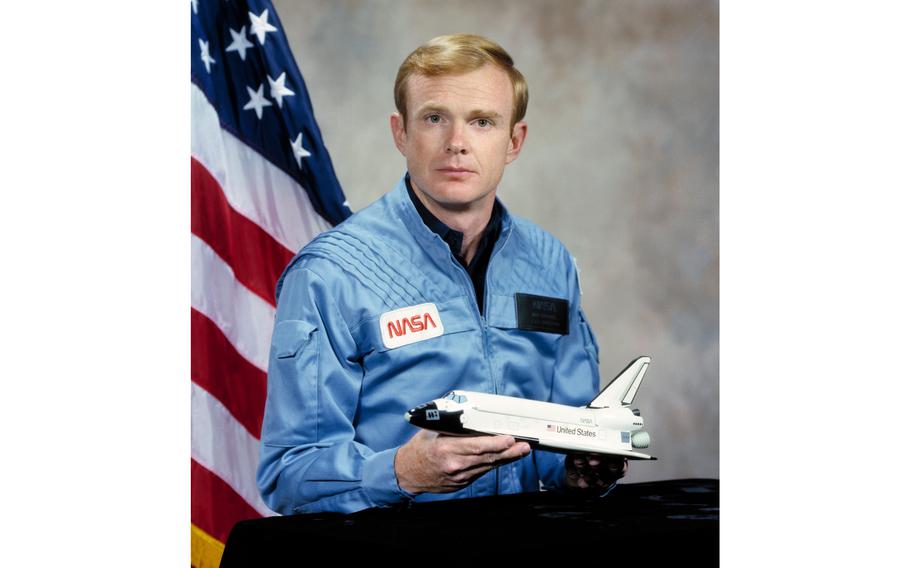
Roy Bridges in 1985. Bridges, a Vietnam War veteran and former director of NASA’s Langley Research Center, will be inducted into the Astronaut Hall of Fame in May. (NASA)
(Tribune News Service) — Roy Bridges calls himself an improbable astronaut.
During parts of his childhood in rural Georgia, his home had no indoor plumbing or electricity. He often did his homework by lamplight. His family later moved to Gainesville, Ga., and after years of military service, engineering study and flight training, Bridges got to see the stars.
Now, NASA is thanking him for his decades of contribution to space exploration. He will be inducted into the Astronaut Hall of Fame in May.
“That was a huge surprise because I only had the one space flight,” Bridges told The Virginian-Pilot by phone on Tuesday. “They told me sometime in either late February or early March, and I figured that running NASA Kennedy Space Center and Langley would qualify me for this.”
Each year, inductees are selected by a committee of Hall of Fame astronauts, former NASA officials, flight directors, historians and journalists. To be eligible, an astronaut’s first flight must have taken place no less than 15 years prior. Candidates must be U.S. citizens and either a NASA-trained space shuttle commander, pilot, mission specialist or an International Space Station commander or flight engineer. Inductees must have orbited the earth at least once, and at least five years need to have passed since their last day eligible for flight assignment as a NASA astronaut.
Bridges, who now lives in Colorado Springs, Colo., said he knew early on that getting to space was his ultimate goal. Russia had sent Sputnik into orbit when Bridges was young, and he was excited by the next level of exploration — which ignited his fascination with the final frontier. The clearest path to becoming an astronaut includes training at the Air Force Academy, which requires a congressional recommendation.
“My father was an avid newspaper reader,” he said. “So he saw a notice in the paper that our congressman was coming to town. I stayed home from school and dressed up in my own suit, and my father got me down to the only hotel in town. He would sit in the car, and I would go cold call the congressman.”
After graduating from the Air Force Academy, Bridges earned a master’s degree in astronautics from Purdue University. Bridges served at Edwards Air Force Base in California after school and got experience with test piloting, a requirement for becoming an astronaut. He served in the Vietnam War and made several other stops during his military career, including Wright-Patterson Air Force Base in Ohio, Nellis Air Force Base in Nevada and what is now Patrick Space Force Base in Florida.
He applied to be part of the 1978 class of astronaut candidates and scored well during his interview, but ultimately, he didn’t get selected. Bridges worked a desk job in the Pentagon for the next couple of years and was on the verge of not applying for the 1980 class. A colleague noticed his application had not come in and called Bridges asking where it was. That’s when Bridges decided to go for it. He was accepted and became part of the 1980 class.
“There were many forks in the road,” Bridges said.
In July 1985, he piloted the space shuttle Challenger for the eight-day Spacelab 2 mission. The main objective was to verify the performance of the shuttle’s Spacelab systems, determine interface capability of the orbiter and measure the spacecraft environment. Experiments covered life sciences, plasma physics, astronomy, high-energy astrophysics, solar physics, atmospheric physics and technology research.
“We were taking pictures for scientists, and I noticed that as we were brought over some of these places, I knew that people down there were really just scraping along trying to survive or having a really tough time,” Bridges said. “And here I am, one of the few hundred people that are getting to fly in space. I had a really exciting job doing things that are good for all humanity, and I felt very special. Maybe a little selfish.”
Bridges was scheduled to fly aboard Challenger a second time during the summer of 1986. But before he could, disaster struck the program. The space shuttle exploded 73 seconds into its January flight, killing all seven astronauts on board. Bridges never made a second trip into orbit, but he stayed within the field of space exploration.
As a pilot, test pilot and astronaut, Bridges flew 4,460 hours in a variety of aircraft. He retired as a U.S. Air Force major general.
He went on to serve as Center Director of NASA’s Kennedy Space Center from 1997 to 2003, where he was responsible for space shuttle and International Space Station programs. Between 2003 and 2005, he served as center director of NASA’s Langley Research Center in Hampton. While at Langley, Bridges was tasked with setting up a new organization called the NASA Engineering Safety Center to correct issues that led to the Challenger explosion and the 2003 space shuttle Columbia disaster.
“There’s absolutely nothing like being onboard that powerful rocket pulling 3 g’s and ending up a couple hundred miles above the planet,” Bridges said. “We floated through the cabin over to the window, and looked at the earth. It’s quite an awesome experience. I never got tired of peaking, although we were very busy, out the window as we went around the world.”
The ceremony for Hall of Fame inductees will take place at at Kennedy Space Center Visitor Complex on May 6.
©2023 Daily Press.
Visit dailypress.com.
Distributed by Tribune Content Agency, LLC.